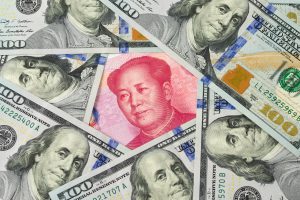Robert Farley

When will China’s economy surpass that of the United States in aggregate terms? A recent Bloomberg article estimated the point of China’s overtaking of the United States at between 2031 and “never.” The magnitude and growth of the Chinese economy have immense global implications, and it is worth taking some time to unpack our beliefs about Chinese growth and its international consequences.
As most know, China already has a larger GDP than the U.S. in purchasing power parity (PPP) adjusted figures, but it continues to lag in nominal terms. The size of China’s economy is absolutely critical to thinking about the future of competition between China and the United States. It is well understood that China already offers a more potent economic power than any competitor that the United States has faced since the late 19th century.
We also have a good sense of the problems faced by China: excessive private sector debt loads, underperforming state owned enterprises, an economy dependent on (apparently precarious) overseas exports, and, most alarming of all, a huge demographic cliff. The Bloomberg study examines all of these, noting that China will need to put in place reforms that increase workforce availability (either through increasing birth rates or extending worker careers), that its infrastructure is overpriced and underperforming from an efficiency point of view, and that individual worker productivity needs to reach developed country levels. China catches the U.S. in the 2030s in two of the three models, depending on aggressive labor market reforms and continued access to the U.S. market.
Of course, the United States faces challenges in the same areas as China, which will necessarily affect any long-range projections. U.S. birth rates have declined in the wake of the pandemic, and the traditional American solution of relative openness to immigration has become increasingly difficult in political terms. While China may have overinvested in capital stock and infrastructure, the United States continues to chronically underinvest due to political gridlock. The U.S., thus, has considerable work to do to maintain competitiveness. It is also probably worth thinking about how and what the the United States might do in order to reduce Chinese economic growth, including aggressive decoupling and the stringent use of financial and technology sanctions.
We should be cautious in interpreting raw figures as destiny; as Gideon Rachman notes, China has yet to fully embrace the idea of becoming a global superpower, just as it has yet (for example) to measure the difficulty of maintaining and upgrading the massive navy it has built. It is also worth noting that no few economists estimated in the 1950s and 1960s that the Soviet economy was bound to overtake that of the United States. Still, Chinese economic growth has been the dominant fact of 21st century international relations, and will continue to shape global politics for the rest of the century.
No comments:
Post a Comment